Table of Contents
Dynamo hubs are quite widely adopted in the bicycle touring, bikepacking and ultra racing scenes. With LED light technology allowing for 1300 lumens (or 100+ lux) light outputs, USB charging for gadgets and lithium-ion battery storage – dynamo hubs feel like the right way to harvest energy.
But where does this energy come from, and to what extent does it slow us down?

If you’ve ever picked up a dynamo hub and tried to spin the axle, you’ll know that they feel incredibly ‘notchy’. This is the result of a series of powerful magnets passing a coil and in turn, creating an electric charge.
The writers at FahrradZukunft put together some lab tests a few years ago to find out more about dynamo hub drag. Let’s take a look at their testing, the data and then draw some conclusions about the effect of dynamo hub drag on our speed.
Note: This article has been superseded with new data and calculations presented HERE.
The Lab Test
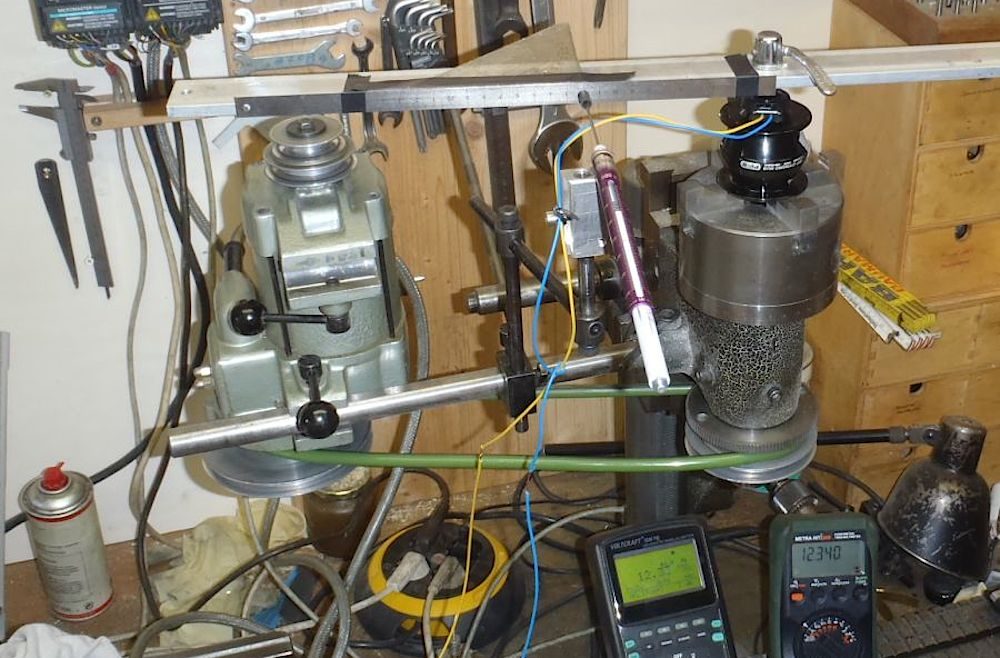
The different dynamo hubs were clamped into a lathe and spun to different speeds. The speed was determined simply by measuring the frequency of the generator with the known number of pole pairs. A supporting load was applied to the opposite end of the hub to replicate the downward force of a fork, and a 12-ohm electrical load resistor is connected to replicate a standard dynamo lighting system. With everything set up, the drive power is then calculated.
The Results
Light Switched OFF While Cycling @ 10-30km/h
Schmidt SON28 // 0.25w-1.25w drag
Schmidt SONdelux // 0.25w-1.25w drag
SP Dynamo PV8 // 0.50w-1.75w drag
Shimano DH-3N80 // 0.50w-2.50w drag
Sanyo H27 // 1.00w-6.00w drag
The lowest drag hubs with the light switched OFF are the SON hubs. They’re rolling almost as efficiently as a regular hub despite having the dynamo infrastructure. The SP Dynamo hub is the next most efficient, followed by the Shimano DH-3N80 hub. The Sanyo H27 is clearly the least efficient dynamo hub and was almost 5x less efficient than a Schmidt hub at 30km/h.
Light Switched ON While Cycling @ 10-30km/h
Schmidt SONdelux // 2.50w-6.50w drag
SP Dynamo PV8 // 2.75w-7.00w drag
Schmidt SON28 // 3.00w-6.50w drag
Sanyo H27 // 3.75w-7.25w drag
Shimano DH-3N80 // 3.50w-7.50w drag
The lowest drag hub is the SONdelux. Next is the SP Dynamo which achieves a marginally lower drag than the SON28 at 10km/h, but is 0.5w higher at 30km/h. The Shimano DH-3N80 performs well at slower speeds, but is the least efficient hub option at 30km/h. The Sanyo H27 is surprisingly efficient when switched on, in fact, it’s MORE efficient than the more expensive options at high speeds!
Other Comparable Data
Schmidt has conducted their own testing for the SONdelux, SON28 and Shimano DH-3N80 hubs. The results fall very closely in line with the independent testing conducted by FahrradZukunft, but their data shows slightly less drag on all three hubs between 10-30km/h. This could be due to a different electrical load applied to the hubs.
Light Switched OFF While Cycling 10-30km/h
Schmidt SONdelux // 0.25w-1.00w drag
Schmidt SON28 // 0.25w-1.50w drag
Shimano DH-3N80 // 0.50w-2.00w drag
Light Switched ON While Cycling 10-30km/h
Schmidt SONdelux // 1.80w-6.10w drag
Schmidt SON28 // 2.15w-6.50w drag
Shimano DH-3N80 // 2.30w-7.25w drag
The Effect On Your Speed
We now have an idea of the numbers, but how does this translate in terms of speed?
Let’s compare two different rider weights (60 and 80kg) and gear weights (15kg and 30kg). I’ll adjust the power (effort) to be more in line with each of those rider weights too (100w and 150w). We can assume the drag of a non-dynamo hub is 0.5 watts. I’ve taken the dynamo hub drag at the different speeds and subtracted 0.5 watts in order draw a direct comparison.
The calculations have all been done with BikeCalculator.com which I’ve found to be very accurate from prior testing.
60kg rider / 15kg Bike and Gear / 100 watts / Non-Dynamo Hub = 24.34km/h.
Most efficient hub: off – 24.29km/h (0.5w extra drag) +0.2%
Least efficient hub: off – 23.94km/h (4.0w extra drag) +1.6%
Most efficient hub: on – 23.82km/h (5.25w extra drag) +2.1%
Least efficient hub: on – 23.71km/h (6.25w extra drag) +2.6%
60kg rider / 30kg bike and gear / 100 watts. Non-Dynamo Hub = 23.83km/h.
Most efficient hub: off – 23.78km/h (0.5w extra drag) +0.2%
Least efficient hub: off – 23.42km/h (4.0w extra drag) +1.7%
Most efficient hub: on – 23.29km/h (5.25w extra drag) +2.3%
Least efficient hub: on – 23.19km/h (6.25w extra drag) +2.7%
80kg rider / 15kg bike and gear / 150 watts. Non-Dynamo Hub = 27.96km/h.
Most efficient hub: off – 27.92km/h (0.6w extra drag) +0.1%
Least efficient hub: off – 27.60km/h (4.75w extra drag) +1.3%
Most efficient hub: on – 27.53km/h (5.75w extra drag) +1.5%
Least efficient hub: on – 27.46km/h (6.60w extra drag) +1.8%
80kg rider / 30kg bike and gear / 150 watts. Non-Dynamo Hub = 27.51km/h
Most efficient hub: off – 27.47km/h (0.6w extra drag) +0.2%
Least efficient hub: off – 27.15km/h (4.75w extra drag) +1.3%
Most efficient hub: on – 27.07km/h (5.75w extra drag) +1.6%
Least efficient hub: on – 27.01km/h (6.60w extra drag) +1.8%
The Effect On Your Riding Time
Using the speed data, we can work out how drag translates in terms of time:
– The most efficient dynamo hubs when switched OFF add between 17 and 30 seconds to a flat ride over 100km when compared to a regular hub.
– The most efficient dynamo hubs when switched ON add between 3min 24sec and 5min 47sec to a flat ride over 100km when compared to a regular hub.
Does Dynamo Hub Drag Really Matter?
Only a little.
To put dynamo hub drag into perspective we can compare the 1.5-2.7% slower speeds with a:
– 7.9% slower cycling speed when using four panniers as opposed to bikepacking bags
– 5.4% slower cycling speed when using Schwalbe Marathon Mondial tyres as opposed to Schwalbe Almotion
– 3.2% slower cycling speed when carrying 30kg extra luggage on a flat road
Given the leverage of a wheel and the flywheel effect of the rotating mass, dynamo hub drag only has a small effect on your speed. The result for most people is likely to be an extra three to six minutes riding time over 100km, all while getting a good charge to your electronics (or while running lights).
On CyclingAbout, you can also learn about:
The Best Dynamo USB Chargers
The Best Dynamo Lights
The Best Buffer Batteries For Dynamo Systems
How To Set Up A Dynamo System


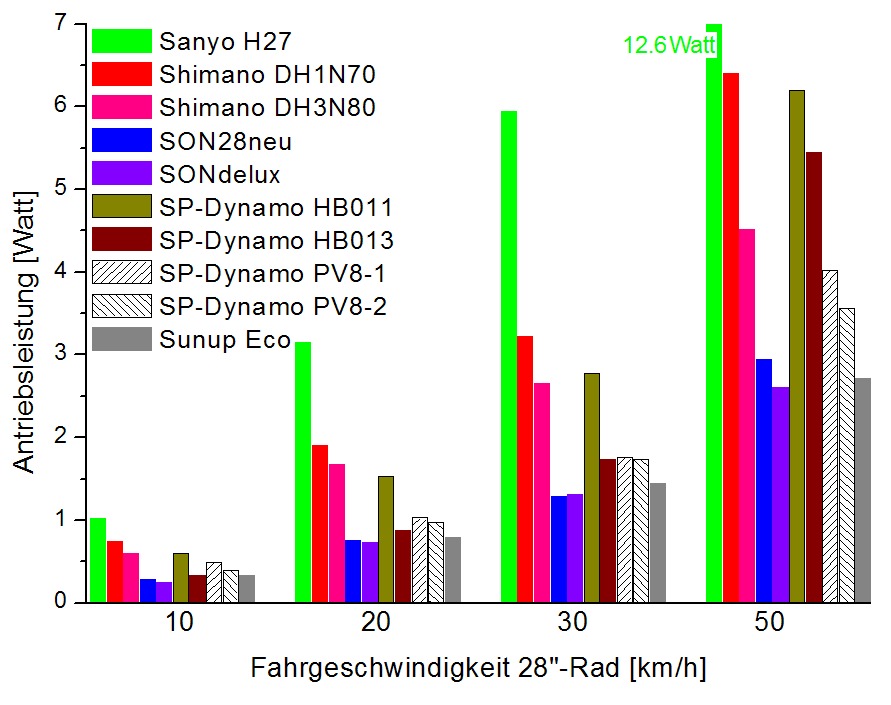
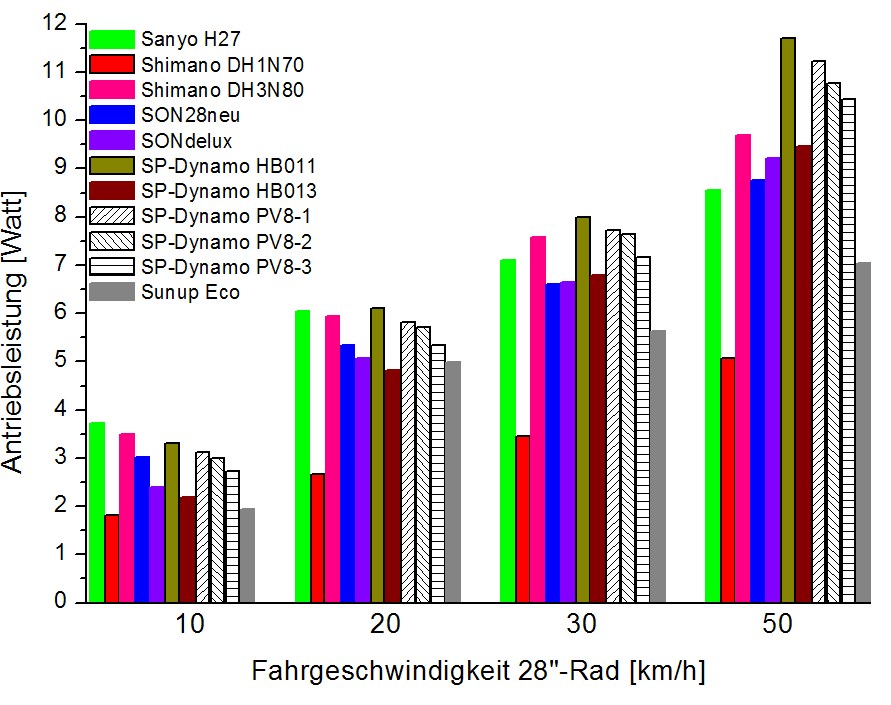
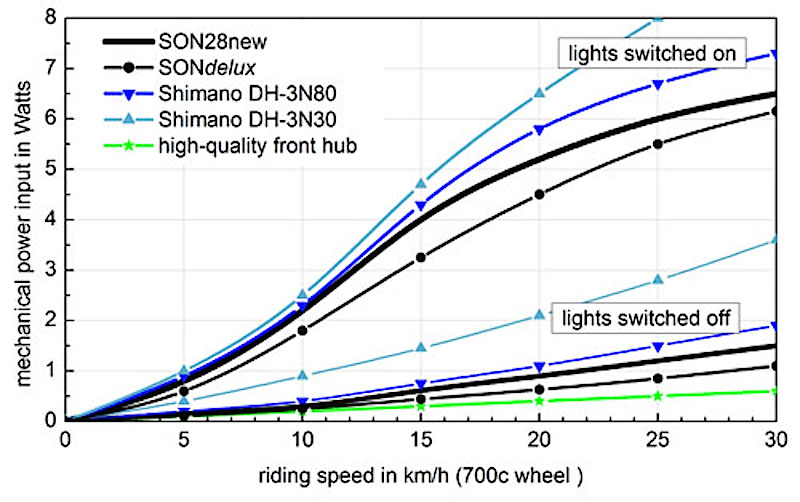
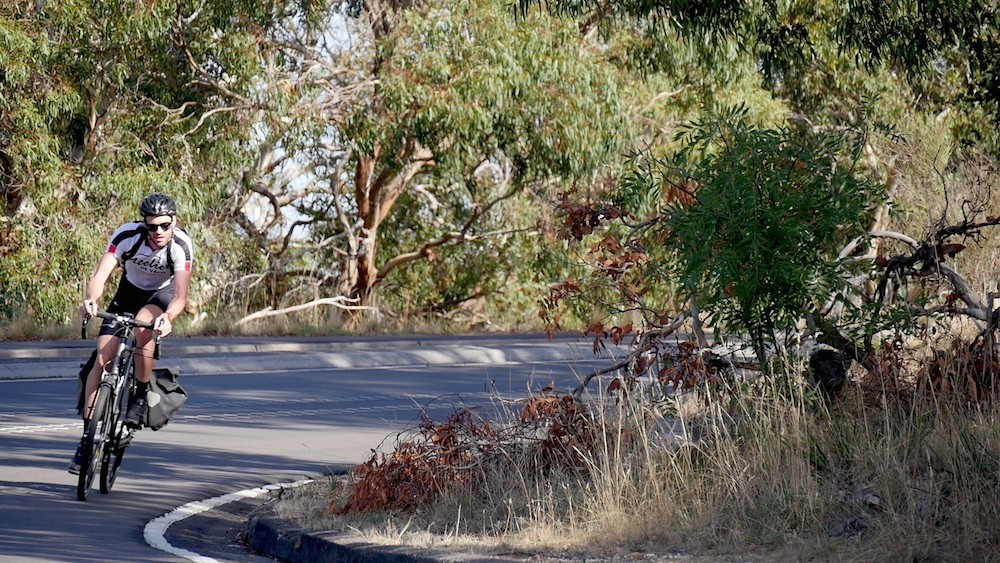
Great article, I’ve always been curious about the effects these hubs jad on your ride. Much less tjan expected
http://spottymoz.com
Most complete article! I was thinking on buying a dynamo hub and with the future purchase this will be the source of my decision!
Excellent article Alee. I run dyno hubs when needed. Reason is if they need servicing it is a costly exercise to remove the hub and send them back to the manufacturer.
The weight of the dynamo hub also need to be considered?
The 250g weight penalty is very minimal. See my weight testing articles to get an idea how many seconds it adds over 100km.
Thanks for this article. Being a regular Fahrradzukunft reader, the main data was already known to me but your calculations add practical value to the german comparative test. Besides, your translation into english language makes it accessible to a much larger audience.
Now some input from me:
1. In today’s SP-dynamo catalog there are some new models that offer lower weight and/or lower drag than the PV-8 model tested by Fahrradzukunft.
2. SP-dynamo hubs are good products but according to my own experience and the experience of other SP-dynamo users around me, they are somewhat less reliable than SON hubs.
3. Shimano dynamo-hubs can be serviced by (very) good mechanics. As far as I know, SON hubs and SP-hubs can be serviced only by the manufacturer (i.e. in case of malfunction they have to be returned to Germany respectively to Taiwan).
great post. ty!
Thanks Martin. Most of the stuff I write about uses information that’s already available, but I just try to make it as practical and easy to read as possible. 🙂
I’d also love to see how the latest SP-Dynamo hubs test a few years on. Thanks for your input.
Very thorough tests and information, Thank you! After seeing these results I think I’ll bag the idea of having an extra non-dynamo front wheel built up. Not necessary!
It’s really not that much drag when switched off!
Would having a dynamo “unplugged” be the same as having it turned off? I’m running a newer SP-Dynamo PD-8 and use an Igaro D1 to charge but don’t have it plugged in all the time (i.e. during short rides where I don’t need it). I’m also guessing the the Igaro connected to my phone or a battery bank would have a different pull on the dynamo than a light system, but would it be more or less? It would be cool to see this test replicated with a single dynamo but different configurations of lights, battery banks, usb converters, etc.
The Igaro D1 will take barely anything without an output source, and different lights, USB devices and batteries will all have a slightly different pull. It’d be awesome to see how different electric systems take power, totally agree!
So Ive been wasting money on EPO to power my SP hub riding around Thailand here?
it seems to boil down to about 0,5 kmh slower, or if kept on for safety, around half an hour slower on a pbp. or comparable to having 20 kg extra load on a flat road. that compares to a lot of 18560 batteries. do the randonneurs know this:)?
First time I’ve seen this experiment done. Good job.
I am a keen cyclist and use a SON 28. I also used to work as an electronics engineer. So if I may be so bold as to offer a suggestion:
Most dynamo lighting these days use LEDs which are normally with switched regulators; important otherwise excessive speed would result in overvoltage and blown LEDs.
By performing your experiment using a simple 12 Ohm resistor as a load you will get slightly higher power loss than you would with a switched regulator which would limit the power going to the LED in an efficient way.
So above 20kph they would probably be less power consumed resulting in less drag.
Cheers
I used an SP PD8X (with Marathon Supreme tires) on my Surly LHT last year touring from Vancouver, Canada to San Jose, California (2,000 km) averaging 100 km / 800 m climbing daily. As far as I know, the SP PD-8X has a much greater efficiency than the dynamos tested above. Unfortunately, my dynamo bearings failed on day 18 (2 days before we were scheduled to arrive home in San Jose). Since the hub was non-serviceable, I was forced to retire it and have my spouse bring my old wheel to the campground. After putting my old wheel back on the bike, the difference is rolling resistance that last two days was huge! My son also noticed I was riding significantly faster than usual. So while I don’t doubt the efficacy of your testing, it’s hard to believe it only added 3-6 minutes to my daily ride.
I’ve had a PV-8 and PD-8 with premature failed bearings. Strangely the replacements have been good to date. I’m guessing bearing or assembly problems. With the noticeable drag you experienced could it be your bearings, whilst slowly deteriorating, were increasing drag subtly without being aware of it?
Thanks. Good to hear. The warranty replacement looks like a new generation product, so I trust it will last much longer. I haven’t used it since the rebuild. Still using the OEM wheel that came on my Surly Trucker. Much less need for a dynamo to power lights and recharge USB devices when not doing multi-day tours.
Thank you ,great article
There was no comparison of output power. Test did not measure how much current is going through the 12 ohm resistor. In this test/translation word “efficiency” was used strangely, and I didn’t understand did it mean drag, power or energy-in/energy-out comparison like word efficiency means.
They only measured *drag in watts*. We need to know also output in watts.
People who are using a lot of electronic devices take electricity from dynamo allways and prefer to know the electric output in watts and compare that with the drag in watts. They would choose the dynamo with highest output and with lowest drag compared to output. Just drag information is important to those who don’t need electricity.
Can you find out that info ?
You’re right, the output power comparison would be interesting. I guess the reason they didn’t test it was that output power is typically VERY close to 3W on most of the hubs (1.5W on the Shimano 1N70). You can boost the output through electronic circuitry, but it of course increases the resistance at the hub. This comparison uses the same light on multiple hubs at varying speeds.
With regards to the usage of the word ‘efficiency’, my terminology across the site tends not to quite align with engineering terminology. This is to make it easier to read and understand for people with a less technical background. In this case, it’s the power difference between pushing the pedals and the light output. Less pedalling effort to achieve the same light output being the more efficient.
If this test did aim to same light brightness in all cases, and light output was measured with light meter, then it actually DID measure efficiency. If it didn’t measure light brightness then it didn’t give info on efficiency. But simple resistor don’t emit light! Current and voltage information together would tell power (watts) IF it was measured. Was it? If not measured then output is a mystery.
I have been commuting for 10 years by bicycle and have not noticed any tangible difference between a dynohub and a regular hub. Though my commute is only 8km each way. What I have noticed that makes a huge difference are bottle dynamos. I have one bike with one and it caps my speed at around 25 km/h even downhill. If I disengage the dynamo I can easily hit 40 going downhill. Though I really don’t mind this as speed is not my goal.
Overall I feel the benefits gained from having an always on lighting system that will not run out of batteries outweighs any loss. But I ride to get around and not for sport or exercise. As my bike alone is already ~30 kg, I don’t worry about added weight.